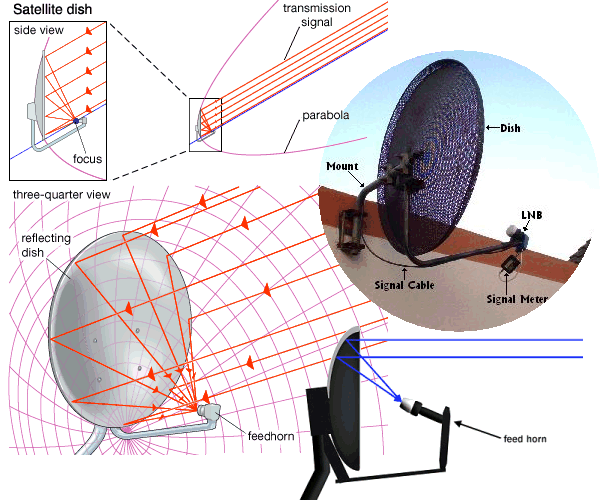Television Satellite Dish Reference
A Satellite Dish is a type of antenna. Satellite dishes are often shaped like portions of a paraboloid (a parabola rotated about its central axis) in order to focus transmission signals onto the pickup receiver, or feedhorn. Typically, the section of the paraboloid used is offset from the centre so that the feedhorn and its support do not unduly block signals to the reflecting dish.
A satellite dish works similar to a TV antenna with the exception that it is intended to pick-up the weak ultra high frequency satellite transmissions, down-convert the frequency and place them on the coaxial cable. The Dish is made up of several components – The dish itself, an LNB and an actuator for motorised dishes.
The receiving dish works in the exact opposite way of the transmitter. When a beam hits the curved dish, the parabola shape reflects the radio signal inward onto a particular point, just like a concave mirror focuses light onto a particular point. The point is the dish's feed horn, which passes the signal on to the receiving equipment. In an ideal setup, there aren't any major obstacles between the satellite and the dish, so the dish receives a clear signal.
In some systems, the dish needs to pick up signals from two or more satellites at the same time. The satellites may be close enough together that a regular dish with a single horn can pick up signals from both. This compromises quality somewhat, because the dish isn't aimed directly at one or more of the satellites. A new dish design uses two or more horns to pick up different satellite signals. As the beams from different satellites hit the curved dish, they reflect at different angles so that one beam hits one of the horns and another beam hits a different horn.
The central element in the feed horn is the low noise blockdown converter, or LNB. The LNB amplifies the radio signal bouncing off the dish and filters out the noise (radio signals not carrying programming). The LNB passes the amplified, filtered signal to the satellite receiver inside the viewer's house.
How to calculate what size dish you need
For most of the continental US you can use a 75cm dish. Fringe areas may need a 90cm or larger dish depending on which satellite your trying to obtain signal from. You can use this chart to double check to see if a 75cm dish will be large enough.
| C-Band | Ku-Band | ||||
|---|---|---|---|---|---|
| EIRP (dBW) |
C Band Dish Size (meters) |
C Band Dish Size (Feet) |
EIRP (dBW) |
KU Dish Size (centimeter) |
KU Dish Size (inches) |
| 39.0 | 1.9 | 6.2 | 50.0 | 55 | 21.65 |
| 38.0 | 2.1 | 6.8 | 49.0 | 60 | 23.62 |
| 37.0 | 2.3 | 7.5 | 48.0 | 65 | 25.59 |
| 36.0 | 2.6 | 8.5 | 47.0 | 72 | 28.35 |
| 35.0 | 2.8 | 9.1 | 46.0 | 77 | 30.31 |
| 34.0 | 3.1 | 10.1 | 44.0 | 95 | 37.40 |
| 33.0 | 3.5 | 11.4 | 42.0 | 115 | 45.28 |
| 32.0 | 3.9 | 12.8 | 40.0 | 138 | 54.33 |
| 31.0 | 4.3 | 14.1 | 38.0 | 175 | 68.90 |
EIRP - Abbreviation for Effective-Isotropic-Radiated-Power
C Band - the frequencies in the 4 to 6 GHz range used both for terrestrial microwave links and satellite links
Ku Band - the frequency range from 10.5 to 17 GHz; in satellite communications, the frequency band 13.75 to 14.50 GHz for transmission, and 10.7 to 12.75 GHz for reception
